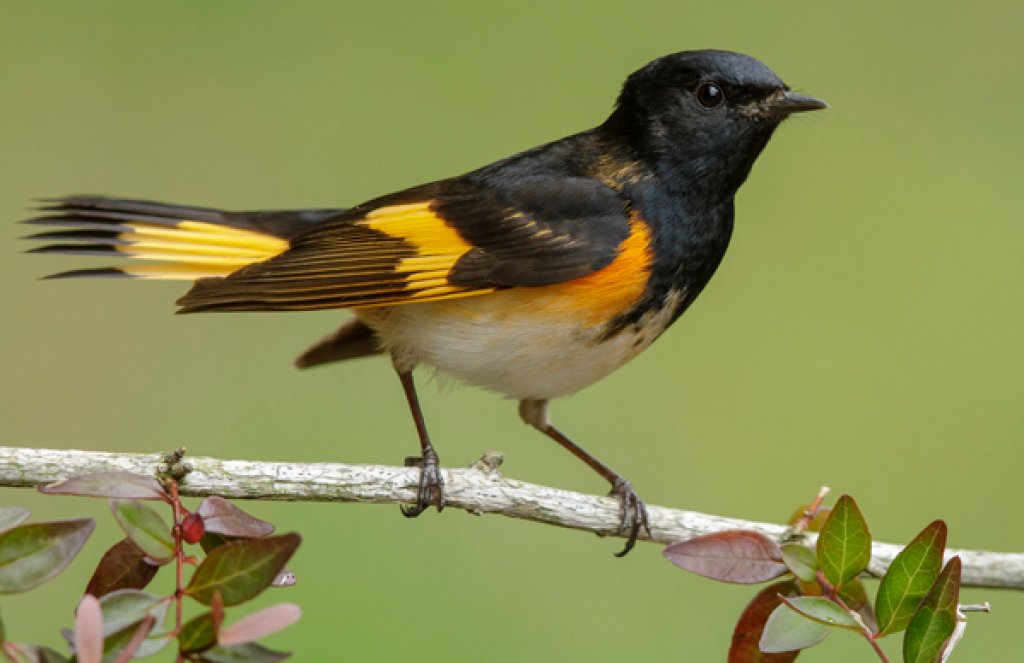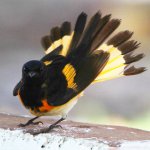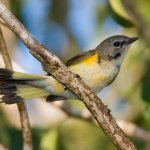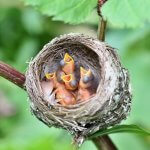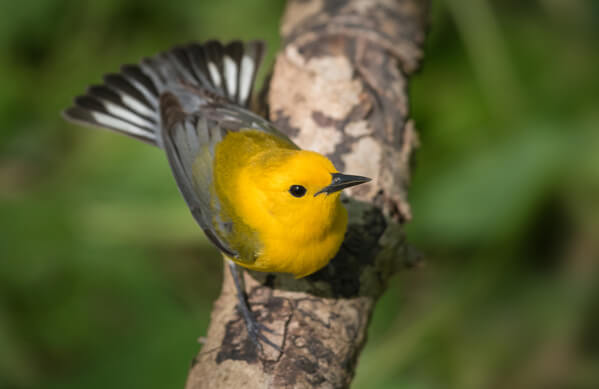About the American Redstart
The American Redstart is one of North America's most recognizable wood-warblers, named for the adult male's glossy black plumage set off by vivid reddish-orange patches on its sides, wings, and tail. Females and young birds, often called "yellowstarts" by birders, are olive-brown above, with lemon-yellow patches on the sides, wings, and tail.
Unlike many warblers of its family, such as the Prothonotary, Wilson's, and Hooded Warblers, the adult male American Redstart lacks yellow plumage.
The word "start" in this bird's name comes from an Old English word for "tail.” An American Redstart constantly flicks its tail open and closed like a fan, flashing patches of bright orange or yellow. In Latin America, it is often called candelita, or "little candle."
The American Redstart is also identifiable by characteristics seen in birds belonging to an entirely different family.
Flashy and Flycatcher-like
The American Redstart's short, rather flat bill, surrounded by stiff, whisker-like rictal bristles, resembles the bills of unrelated insectivorous birds of the New World flycatcher family, such as the Great Crested Flycatcher, Santa Marta Bush-Tyrant, and Eastern Phoebe. These features help the American Redstart catch insect prey while in flight, which it does more regularly than other warbler species.
Songs and Sounds
The high-pitched, extremely variable song of the American Redstart can be tricky to learn. One of these sounds very much like that of a Yellow Warbler, another like a Black-and-white Warbler. See if you can tell the difference!
Breeding and Feeding
Territorial Trials
The American Redstart is highly territorial throughout the year. On the breeding grounds, male redstarts court newly arriving females with behaviors similar to those usually used in defensive displays, including in-flight chasing and vigorous posturing.
A male will show his mate several potential nest sites within a territory, but the female makes the final site choice. She builds a cup-shaped nest using bark strips, grass, plant down, and other natural fibers, and lines it with soft materials that include fur and feathers. The nest is “glued” with spider silk to the forked branches of a tree or shrub, well-hidden within the foliage.
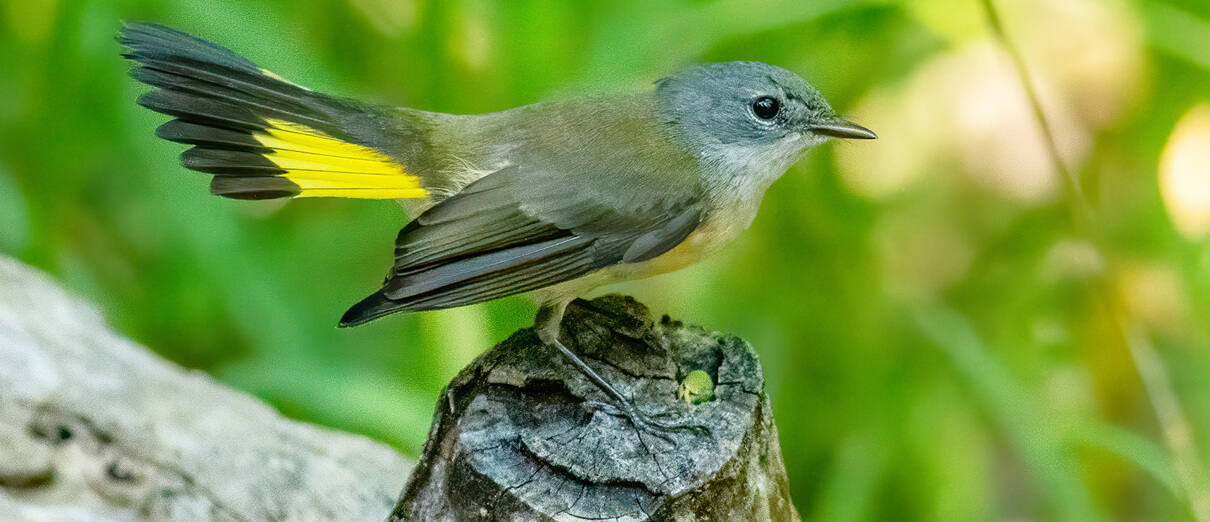
The female redstart lays an average of three to four eggs, which she incubates herself for 10 to 13 days. Once the young hatch, both parents feed them for several weeks until fledging. Once the young are out of the nest, the parents split the brood, each continuing to feed one or two offspring for a few more weeks until they are fully independent. Brown-headed Cowbirds frequently parasitize American Redstart nests, leaving redstart parents to raise cowbird young, to the detriment of their own.
Although American Redstart pairs are usually monogamous during the breeding season, extra-pair copulation is common among both sexes, resulting in nestlings with mixed paternity. Occasionally a male redstart will mate with a second female outside of its territory once its first mate is on the nest. These polygamous males usually give more attention to their first brood than the second.
Flashing for Food
The American Redstart is a lively insectivore, especially during its breeding season, hopping among tree branches and foliage to glean its prey, which includes caterpillars, moths, flies, wasps, beetles, aphids, and spiders. It "flashes" its brightly colored wing and tail patterns by fanning its tail and drooping its wings as it forages — behavior that is thought to startle insects into flight, making them easier to capture, and giving this brightly colored little warbler yet another nickname: "the butterfly of the bird world." In late summer, the American Redstart adds small fruits to its diet. Planting serviceberry, magnolia, or other native trees that produce small berries and host a variety of insects might attract migrating American Redstarts to your yard.
Region and Range

The American Redstart is one of the most numerous warblers in North America because its favored habitat, second-growth woodland, covers large areas of the continent.
This colorful songbird breeds across much of the northeastern and central United States and southern Canada, and migrates to wintering grounds in Central America, northern South America, and the Caribbean. Along with other Neotropical migrants such as Scarlet and Summer Tanagers, Chestnut-sided and Golden-winged Warblers, and the Baltimore Oriole, it is a common winter visitor to shade-grown coffee farms in Central and South America.
Conservation of the American Redstart
The biggest threat to this migrant is habitat loss on both wintering and breeding grounds, which affects other birds including Cerulean and Blackpoll Warblers.
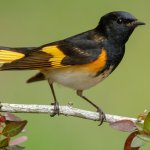
Help support ABC's conservation mission!
As nocturnal migrants, American Redstarts are frequent victims of collisions with glass, towers, and wind turbines; as insectivores, they are vulnerable to pesticide poisoning.
ABC is involved in a number of large-scale conservation initiatives to protect and recover habitat for migratory birds, including BirdScapes and Joint Ventures. ABC's Collisions program offers solutions to keep American Redstarts and other migrating birds safe from collisions.
Donate to support ABC's conservation mission!
Get Involved
Policies enacted by the U.S. Congress and federal agencies, such as the U.S. Fish and Wildlife Service, have a huge impact on migratory birds. You can help shape these rules for the better by telling lawmakers to prioritize birds, bird habitat, and bird-friendly measures. To get started, visit ABC's Action Center.
Living a bird-friendly life can have an immediate impact on migratory birds in the United States. Doing so can be as easy as adding native plants to your garden, avoiding pesticides, and keeping cats indoors. To learn more, visit our Bird-Friendly Life page.
American Bird Conservancy and our Migratory Bird Joint Venture partners have improved conservation management on more than 6.4 million acres of U.S. bird habitat — an area larger than the state of Maryland — over the last ten years. That's not all: With the help of international partners, we've established a network of more than 100 areas of priority bird habitat across the Americas, helping to ensure that birds' needs are met during all stages of their lifecycles. These are monumental undertakings, requiring the support of many, and you can help by making a gift today.





































